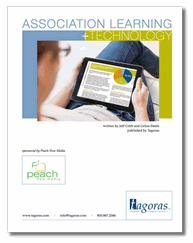Promoting and Leveraging Your Meeting Content

Tight budgets and growing competition are prompting associations to squeeze extra value out of their conferences. Web-based libraries of digitized abstracts and recorded sessions are dramatic value enhancers for members. As we’ll see, they yield many other benefits, too.
The Evolving Event: Changing Success Metrics from Conference Attendance to Conference Participation

An important first step in developing a plan to leverage your meeting content is for your entire team to achieve buy-in on the premise that your conference content has value beyond the actual show. Once this occurs, it allows you to create a plan to efficiently cultivate a tradition that will benefit both the live and virtual audiences. Traditionally when a presenter is selected for a particular presentation, the audience size is limited to the size of the meeting room. Now, that presentation can be delivered to a significantly broader audience.
You may have heard of the term “website impressions,” which indicates the number of times a website ad was viewed or delivered. Presentation “impressions” can now be expanded beyond the four walls of the meeting room and include non-attending members as well as potential members who find value in your content. Even though a meeting has 100 attendees in the room, that presentation can be delivered as part of an online e-newsletter or an e-learning module. As a result, it is possible to multiply the presentation “impressions” by a factor of 10. With the use of reporting tools and analytics, your team can aggregate all the viewing statistics (both live and virtual) and determine the entire participation of the conference content rather than just the live attendance of the conference.
A few years ago, the American Institute of Architects set out to expand the conference participation of their event and was highly successful. Kevin Novak, vice president of new business development and digital strategies, saw a dramatic increase in involvement.
“We streamed 14 general and other sessions resulting in 2,200 onsite participants and more than 17,000 virtual participants. Our actions have resulted in the most positive feedback from the membership on any initiative in the recent memory of the organization. We met our targets for onsite attendance and as a result of the offering experienced our highest ever participation. We were and continue to be very excited with our results and are looking forward to doing much more next year,” he said.
This initiative allowed AIA to grow its session’s participation rate by a whopping 672 percent!
The American Association of Orthodontists has become very effective at managing its spoken word knowledge. AAO captures sessions from their live meetings and webinar series and has built an impressive content library that is only available for members. This content can’t be “Googled” and provides a significant value of membership.
Anita Craig, director of education and membership explains, “Educational membership benefits have become increasingly valued by member doctors and their orthodontic staff teams. (We) provide continuing education through recording of conference sessions, an online distance learning program and webinars. We consider these products, as well as our live conferences, as the core of AAO’s continuing education. The convenience these products have provided added value and CEUs for our members who increasingly take advantage of the any-time, anyplace access. And, the non-dues revenue is a welcome addition to the bottom line.”
Creating a Content Lifecycle Is Not a New Idea
I am a member of several associations and look forward to participating and learning at each group’s annual meeting. However, many times I realize the show will occur during a time or place that makes it impossible for me to attend. Many organizations do not offer an alternative way to participate and learn from the event. It strikes me that their message is “you either attend our conference in our chosen city, at our chosen time, or you get nothing.” Other groups such as the sports industry deliver their games via alternative means for viewers unable to travel to the live event. Why not association meetings?
A great example is how Hollywood recognizes the value of their content. They leverage the value of their movies by delivering their content through a very established life cycle that initially delivers via a theatrical release (in a movie theater), which requires its audience to go to a specific venue to watch the content at a predetermined time. Not too different from our industry. However, that’s where the similarities end. Hollywood then takes that content and delivers it through a number of other channels such as online services (iTunes/Netflix), pay-per-view, DVDs, premium cable, basic cable and then eventually network television. Theatrical (cinema) revenues only account for about 25 percent of the total revenues of a typical movie!
Upward of 75 percent of associations now offer some sort of e-learning programs through their websites, with many more planning to offer them within the next year.
Your Members’ Content Expectations
Today’s professionals expect to be able to get access to meeting content anywhere, anytime, via any device. Meeting attendees are likely accustomed to getting access to most of their information immediately through their mobile devices. If meeting sessions are streamed live or available soon after a session, it can help attendees get more out of their busy conference schedules. Online access is also invaluable to members who cannot make it to a particular conference because of schedule conflicts.
Member recruitment and retention both benefit when your conference lifespan extends beyond the event itself. While nothing replaces the face-to-face networking value of attending an important conference or symposium, combining an on-demand library of meeting content with a well-developed social media outreach program, sparks member conversations and interactions. These can continue long after the conference is over, turning up the volume for the association as a whole. Event sponsors likewise may be delighted to pay for a presence in this virtual market space.
e-Learning Statistics Show Growth!
In years past, association executives expressed concerns about cannibalizing meeting attendance if they put meeting content online. Quite the opposite has occurred, according to implementers. Early adopters have discovered that live audiences have remained steady. These associations have also built whole new audiences that are often willing to pay for online access.
Many position their online meeting libraries as part of their e-learning programs. According to Tagoras, 89 percent of respondents say their association offers tech-enabled or tech-enhanced learning, and 11 percent of respondents say they plan to start using tech-enabled/enhanced learning in 2015. These programs provide professional development opportunities for members, who often have exclusive or lower-priced access to them than non-members. About a third of associations charge for all of their e-learning offerings, while about half charge for some.
 According to the Tagoras June 2014 Association Learning and Technology Report, it is clear that e-learning has become critical for many associations. Here are some highlighted facts:
According to the Tagoras June 2014 Association Learning and Technology Report, it is clear that e-learning has become critical for many associations. Here are some highlighted facts:
- Association success with e-learning: The report found that 80 percent of the responding associations characterized their e-learning as very or somewhat successful.
- Association satisfaction with e-learning: Eighty-five percent of associations with active e-learning programs are very or somewhat satisfied overall with their e-learning initiatives.
- Revenue contribution of e-learning: Revenue from tech-enabled learning still has a ways to go as a satisfactory source of funds for associations: less than half (45 percent) reported being very or somewhat satisfied with the revenue they can earn from online learning. But Tagoras expects that organizations will ditch the platforms and tech choices that aren’t working for them and replace them with systems they and their members are more comfortable with, and that earn the association more revenue.
- Benefits: When asked what the three key benefits associated with e-learning was queried, the top responses were member convenience, cost-effectiveness and the ability to reach more learners.
- Pervasiveness of associations using e-learning platforms: Fifty-one percent of associations report using a learning management system, up from 32.6 percent five years ago.
Best Practices and Getting Started
Association executives are finding that the initial investment to create an online library increases overall returns to the organization through:
- New memberships
- Better retention of existing members
- Creating new revenue streams through virtual proceedings and extended sponsorships
- Extending the reach of the brand
Groups eager to begin often don’t know where to start. We generally advise them to begin with one or two pieces of the total solution, such as recording the conference sessions or digitizing abstracts and posters. This is an easy way to increase your audience and leverage your content far beyond the meeting itself. When designing your online library for these materials, you can design for the seamless addition of audio and video materials, which can be readily added at any point.
Phil Forte has been involved in the formation and development of successful technology companies for the meetings industry for more than 20 years. He is the founder and president of Blue Sky Broadcast.

